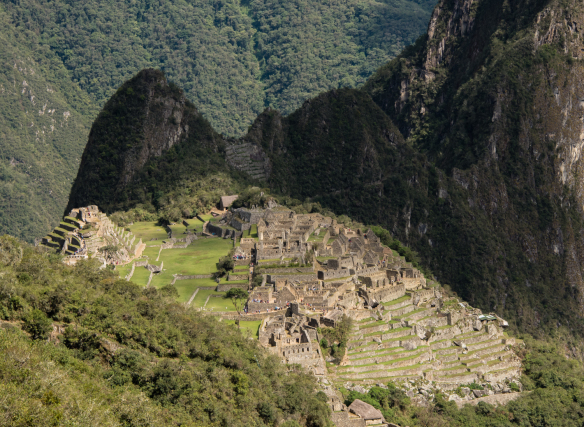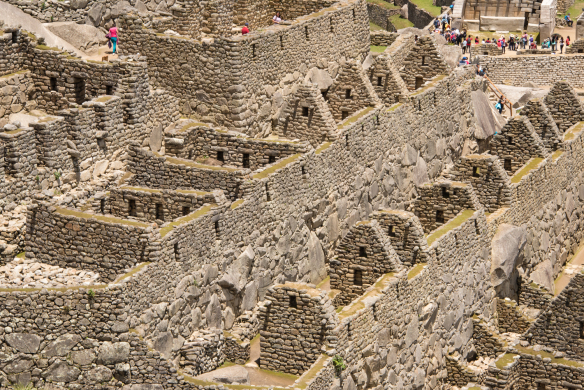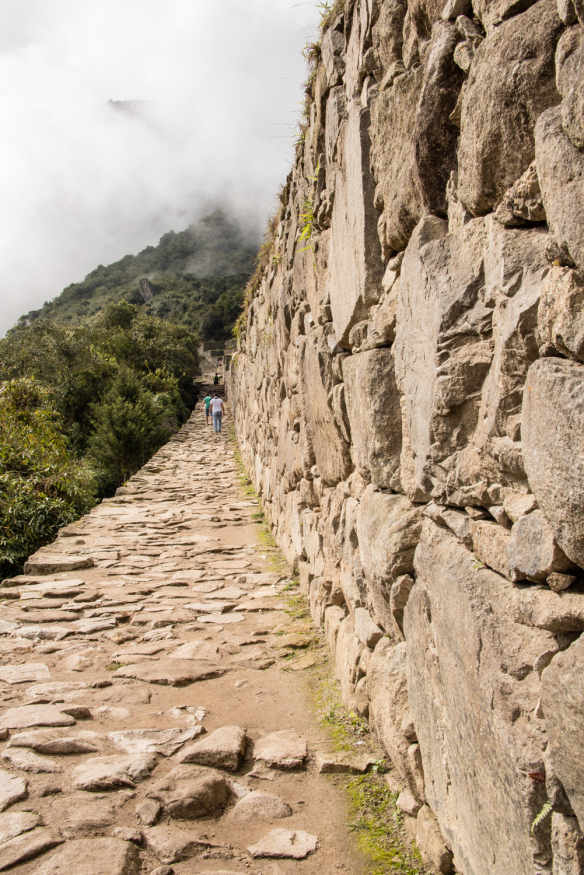A first view of Machu Picchu from the Inca Trail’s Sun Gate
It was with great excitement and anticipation that many months ago we planned our trip, joined by several friends and other Residents of the Ship, to Machu Picchu from Cuzco.
For the Incan pilgrims, this journey from the Incan capital city, Qosqo (Cuzco), to Machu Picchu via the so called “Inca Trail” may have taken three or four days over several mountains and quite a lot of vertical ascents and descents, notwithstanding the fact that Machu Picchu is 3,180 feet or 969 meters lower than Qosqo (Cuzco).
 Panoramic view of Machu Picchu, Peru, from the Inca Trail, descending into the
Panoramic view of Machu Picchu, Peru, from the Inca Trail, descending into the
valley from the Sun Gate
The so-called “Sun Gate” (the Incas called it “Inti Punku”) is the Inca Trail entry into the valley and plateau of Machu Picchu, which sits about 1,000 feet (305 meters) below the portal.
 The Inca Trail’s Sun Gate’s entrance to the last portion of the trail down into,
The Inca Trail’s Sun Gate’s entrance to the last portion of the trail down into,
and the first glimpse of, Machu Picchu, Peru
Abandoned by the Incas shortly before the Spanish conquest of the Inca capital city of Qosqo (Cuzco) in 1533, Machu Picchu is one of the few Incan masterworks that did not suffer excessive alterations in the intervening centuries before its “scientific” discovery by Yale University professor Hiram Bingham in 1911.
The Peruvians, aware that Machu Picchu is an UNESCO World Heritage Site, in order to help preserve it, now limits the number of daily foreign visitors to 2,500. Access to climbing Huayna Picchu, with its spectacular views of Machu Picchu, is even more restricted — a group of 200 (maximum) departing daily at 7 a.m. and another 200 at 10 a.m.
 A close up view of the hiking steps carved near the top of Huayna Picchu
A close up view of the hiking steps carved near the top of Huayna Picchu
mountain, adjacent to Machu Picchu, Peru
 From the Inca Trail, a close-up view of Machu Picchu, Peru
From the Inca Trail, a close-up view of Machu Picchu, Peru
The last section of the Inca Trail entering Machu Picchu is well paved with stones, on a terrace next to a stone retaining wall, affording excellent views of the site.
According to Saydi Maria Negron Romero, “Machupicchu was erected in relation to the Sun and its trajectory through the firmament. Each space built is oriented in order to receive the greatest amount of solar light and heat, during more hours per day, and every day of the year. The city’s distribution goes from East to West and from North to South, as it connects with a sacred landscape, in which snow-capped mountains can be seen in the distance, as well as other nearby ones that coincide with the four cardinal directions.”
 The Upper and Lower Urban Sectors of Machu Picchu, Peru
The Upper and Lower Urban Sectors of Machu Picchu, Peru
 Close up of terraced buildings in the Lower Urban Sector of Machu Picchu, Peru
Close up of terraced buildings in the Lower Urban Sector of Machu Picchu, Peru
 Close up of terraced buildings in the Upper Urban Sector of Machu Picchu, Peru
Close up of terraced buildings in the Upper Urban Sector of Machu Picchu, Peru
The Temple of the Sun, in the upper urban section of Machu Picchu, had no roof as it was also an astronomical observatory and was used to predict the passing of the Sun through the zenith.
 Temple of the Sun in the Upper Urban Sector of Machu Picchu, Peru
Temple of the Sun in the Upper Urban Sector of Machu Picchu, Peru
Ready to learn more?
Determine whether life aboard The World is the right fit for you. Talk to one of our Residential Advisors today to learn more about this unique lifestyle, details of upcoming Journeys and Expeditions, and ownership opportunities.




